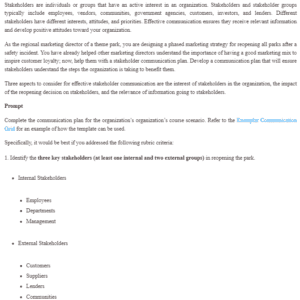Developing a Communication Plan for Stakeholders
Two Crisis Communication Methods
During a crisis, it is important to have a plan to communicate with stakeholders. Crises include natural disasters, accidents, and other unforeseen events that might need to be addressed timely (Ndlela, 2019). For the theme park, crisis communication methods that could be used include face-to-face meetings and press releases. When communicating with stakeholders, it is essential to be clear and concise about the message. Face-to-face meetings allow for a two-way conversation where questions and concerns can be addressed. The crisis can be explained in detail, and the stakeholders can be reassured that appropriate steps will be taken to prevent a repeat of the incident. Stakeholders can have confidence in the organization when communication is open and transparent. They can ask questions and get answers promptly. Hire our assignment writing services if your assignment is devastating you.
A press release is another communication method to communicate with stakeholders during a crisis (Ozanne et al., 2020). A press release is a formal statement issued to the media to share information about an event or situation. The press release can share information about the organization’s steps to improve safety and prevent future accidents. It can also be used to share information about the actions taken to help the accident victims. The press release can be a way to show the stakeholders that the organization is taking responsibility for the incident and is committed to making changes to improve safety. For example, the park can issue a press release to share information about the new safety protocols. The press release can also thank the first responders and the community for their support during this difficult time.
Quick Communication with Internal Stakeholder Groups
The internal stakeholders are the employees of the organization. The quick communication methods to communicate with internal stakeholders are phone calls and text messages (Adamu, Mohamad & Rahman, 2018). These methods can be used to share information about the incident, the steps taken to improve safety, and the changes made to the park. Additionally, employees can be updated on the investigation and changes made to the park regarding the incident. For instance, the line manager could call the employees to update them on the changes made to the park and reassure them that their safety is a top priority. The employees can also be sent text messages with updates on the incident and the steps to improve safety. These communication methods will help keep the employees informed and reassured about the situation.
Quick Communication with External Stakeholder Groups
The external stakeholders are the people near the park and the media. The quick communication methods with external stakeholders are phone calls, text messages, and social media (Adamu, Mohamad & Rahman, 2018). These methods can be used to share information about the incident, the steps taken to improve safety, and the changes made to the park. The external stakeholders could receive updates on how the incident will be handled; they could receive updates on the investigation and changes made to the park. For instance, the park can use social media to share information about the new safety protocols. The park can also use social media to thank the first responders and the community for their support during this difficult time. These communication methods will help inform and reassure the external stakeholders about the situation.
References
Adamu, A. A., Mohamad, B., & Rahman, N. A. A. (2018). Antecedents of internal crisis communication and its consequences on employee performance. International Review of Management and Marketing, 6(7), 33-41.
Ndlela, M. N. (2019). A stakeholder approach to risk management. In Crisis Communication (pp. 53-75). Palgrave Pivot, Cham.
Ozanne, L. K., Ballantine, P. W., & Mitchell, T. (2020). Investigating the methods and effectiveness of crisis communication. Journal of Nonprofit & Public Sector Marketing, 32(4), 379-405.
ORDER A PLAGIARISM-FREE PAPER HERE
We’ll write everything from scratch
Question 
Stakeholders are individuals or groups that have an active interest in an organization. Stakeholders and stakeholder groups typically include employees, vendors, communities, government agencies, customers, investors, and lenders. Different stakeholders have different interests, attitudes, and priorities. Effective communication ensures they receive relevant information and develop positive attitudes toward your organization.

Developing a Communication Plan for Stakeholders
As the regional marketing director of a theme park, you are designing a phased marketing strategy for reopening all parks after a safety incident. You have already helped other marketing directors understand the importance of having a good marketing mix to inspire customer loyalty; now, help them with a stakeholder communication plan. Develop a communication plan that will ensure stakeholders understand the steps the organization is taking to benefit them.
Three aspects to consider for effective stakeholder communication are the interest of stakeholders in the organization, the impact of the reopening decision on stakeholders, and the relevance of information going to stakeholders.
Prompt
Complete the communication plan for the organization’s organization’s course scenario. Refer to the Exemplar Communication Grid for an example of how the template can be used.
Specifically, it would be best if you addressed the following rubric criteria:
- Identify the three key stakeholders (at least one internal and two external groups) in reopening the park.
-
- Internal Stakeholders
-
-
- Employees
- Departments
- Management
-
-
- External Stakeholders
-
-
- Customers
- Suppliers
- Lenders
- Communities
-
-
- Use the Communication Grid Template to complete this step.
Identify and analyze the information about each stakeholder group and their communication needs. Use the Communication Grid Template to complete this step. Consider the following points:
-
- Stakeholder’s interStakeholder’srk’s reopening
- Aspark’snt of the impact on stakeholders (low, medium, or high)
- Information and communication needs of the stakeholder
- Communication methods to and with the stakeholder
Identify two crisis communication methods for communicating with stakeholders.
-
- What forms of communication can be used to communicate with internal stakeholder groups quickly?
- What forms of communication can be used to communicate with external stakeholder groups?